इमाः सोम्य नद्यः पुरस्तात्प्राच्यः स्यन्दन्ते पश्चात्प्रतीच्यस्ताः समुद्रात्समुद्रमेवापियन्ति स समुद्र एव भवति ता यथा तत्र न विदुरियमहमस्मीयमहमस्मीति ॥
This is a beautiful verse from the Chandogya Upanishad that describes how rivers flow before eventually merging into the ocean, emphasising their interconnectedness and the vastness of the sea.
Rivers are a vital part of life, providing water for irrigation, livelihood, economical transportation, power and more. These rivers originate from the Himalayas, travelling down to villages and cities and supporting life with their clean water.
But do you know how many rivers there are in India? How do they originate, what are the different types of rivers in india, their names and more? Let’s understand!
Check Out| Which are the Three Deepest Rivers in India, Check Here
What Are River Systems? Everything You Need to Know
India has numerous rivers, with approximately 400-500 rivers flowing across the country. These rivers are broadly classified into four groups:
- Himalayan Rivers: Originating from the Himalayas, these rivers are primarily snow-fed and include major rivers like the Ganges, Brahmaputra, and Indus.
- Deccan Rivers: Located in Peninsular India, these rivers flow into the Bay of Bengal and the Arabian Sea. Examples include the Godavari, Krishna, and Kaveri rivers.
- Coastal Rivers: Short rivers that flow along the western coast of India, predominantly in the states of Kerala and Karnataka.
- Inland Rivers: Rivers that do not drain into the sea, often found in regions like Ladakh and the Thar Desert.
Some of the major rivers in India include:
- Ganga: 2,510 km long, originating from the Gangotri Glacier in Uttarakhand
- Brahmaputra: 2,900 km long, entering India through Arunachal Pradesh
- Indus: 2,900 km long, originating from the Tibetan plateau
- Godavari: 1,450 km long, originating from Maharashtra
- Narmada: 1,290 km long, originating from Amarkantak in Madhya Pradesh
Other notable rivers:
- Yamuna: 1,376 km long, originating from the Yamunotri Glacier in Uttarakhand
- Krishna: 1,290 km long, originating from the Western Ghats in Maharashtra
- Mahanadi: 890 km long, originating from Dhamtri in Chhattisgarh
- Kaveri: 760 km long, originating from the Western Ghats in Karnataka
In Case You're Interested| The 10 Longest Rivers in North America
What is a River System?
Many of you would’ve wondered, where did rivers originate? What is their starting point? So, let’s understand it in a very easy way.
- A river is a natural stream of flowing water.
- When Himalayan glaciers melt, the water flows down the mountains, forming a river.
- The river then gets distributed into small tributaries and distributaries.
- When the river and its tributaries, after collecting water from various sources, including rainfall, melting snow, and underground springs, channel it towards larger bodies of water like seas and oceans. This watershed or drainage basin is called a river system.
List of Major River Systems in India
There are a total of 10 major rivers in India, and together with their tributaries, these rivers create a river system which plays a crucial role in various fields of agriculture, transportation, and hydroelectric power generation. Here's the list of the major river systems in India.
| River System | Total Length (km) | Length in India (km) |
| Indus River System | 3,180 | 1,114 |
| Brahmaputra River System | 2,900 | 916 |
| Ganga River System | 2,510 | 2,510 |
| Yamuna River System | 1,376 | 1,376 |
| Narmada River System | 1,312 | 1,312 |
| Tapi River System | 724 | 724 |
| Godavari River System | 1,465 | 1,465 |
| Krishna River System | 1,400 | 1,400 |
| Cauvery River System | 805 | 805 |
| Mahanadi River System | 851 | 851 |
#1. Indus River System
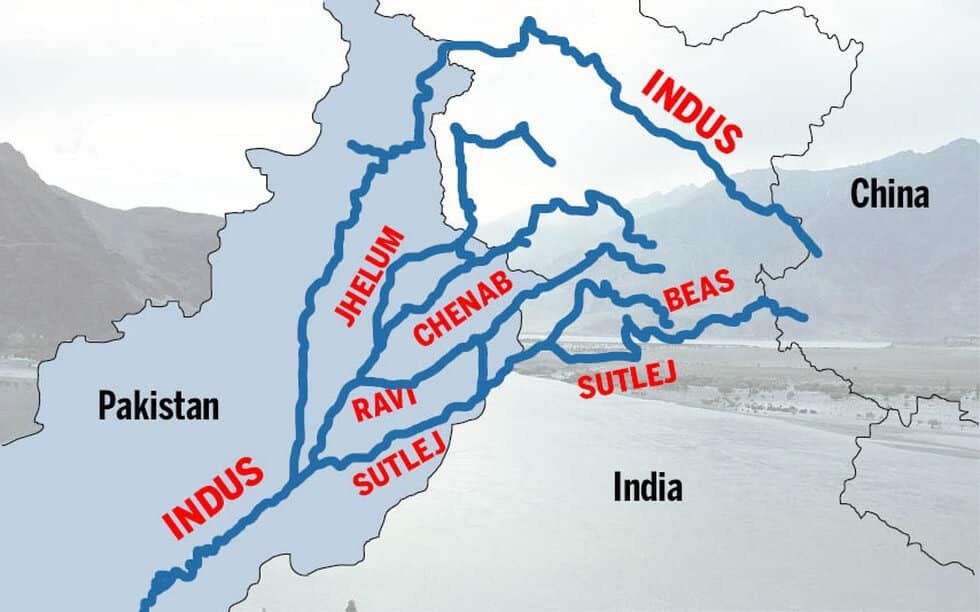
Source: civilspedia.com
- The Indus River originates from the northern slopes of the Kailash range in Tibet, near Lake Mansarovar.
- Stretching approximately 2,897 km, it flows through India and Pakistan before emptying into the Arabian Sea near Karachi.
- In India, the river covers around 700 km, entering Jammu and Kashmir through a scenic gorge. Within the Kashmir region, it converges with several tributaries, including the Zaskar, Shyok, Nubra, and Hunza.
- The Indus flows between the Ladakh and Zaskar Ranges at Leh and traverses the Himalayas via a 5,181-metre-deep gorge near Attock.
- Its major Indian tributaries include the Jhelum, Ravi, Chenab, Beas, and Sutlej rivers.
#2. Brahmaputra River System
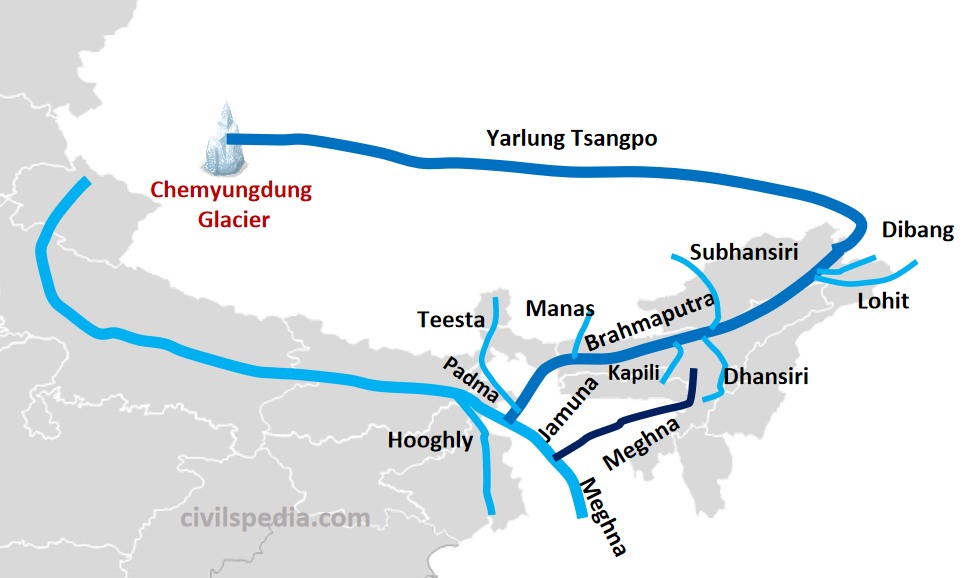
Source: civilspedia.com
- The Brahmaputra River originates from Mansarovar Lake in Tibet, sharing its source with the Indus and Sutlej rivers.
- Stretching 3,848 km, it's slightly longer than the Indus River. Most of its course lies outside India, flowing parallel to the Himalayas before taking a U-turn at Namcha Barwa and entering India in Arunachal Pradesh as the Dihang River.
- In India, it flows through Arunachal Pradesh and Assam, receiving several tributaries. The Brahmaputra is known for its braided channel in Assam and carries significant water and silt due to heavy precipitation in the region.
- It's considered one of India's largest rivers by volume and is prone to causing calamities in Assam and Bangladesh. In Tibet, it's known as the Tsangpo River.
#3. Ganga River System
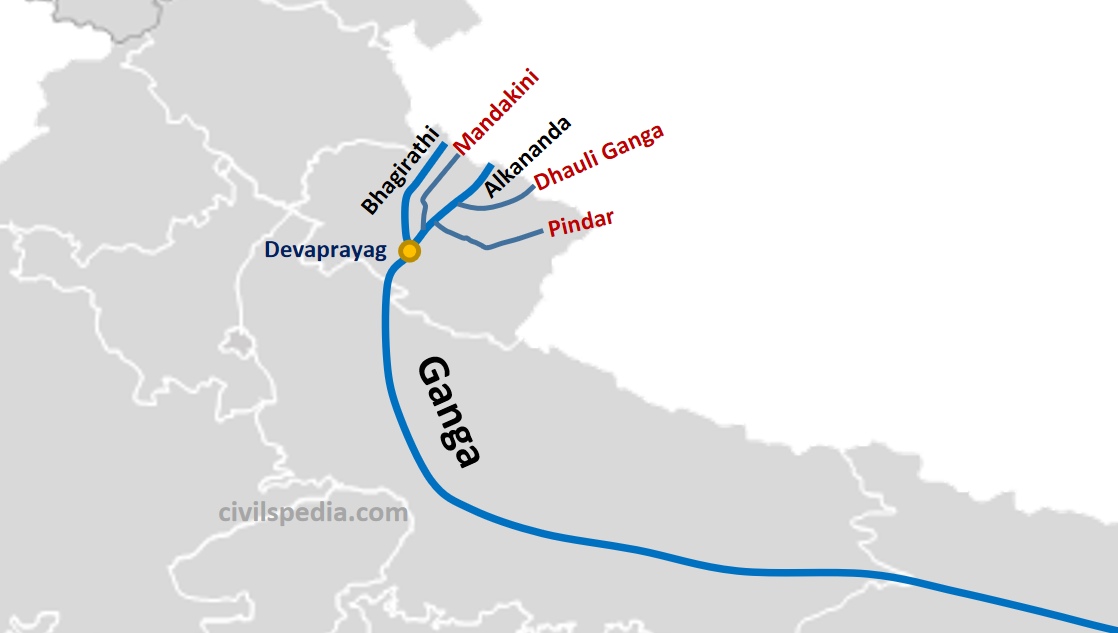
Source: civilspedia.com
- From the Gangotri Glacier, the Bhagirathi River flows down through the Himalayas. It then merges with the Alaknanda River, which originates from the Satopanth glacier at Devprayag, forming the Ganga.
- The Alaknanda River is joined by several tributaries, including the Mandakini, Pindar, and Dhauliganga, at various points known as the Panch Prayag:
- Vishnuprayag (Dhauli Ganga meets Alaknanda); Nandprayag (Nandakini meets Alaknanda); Karnaprayag (Pindar meets Alaknanda); Rudraprayag (Mandakini meets Alaknanda); Devprayag (Bhagirathi meets Alaknanda, forming the Ganga)
- The Ganga's principal tributaries include the Yamuna, Damodar, Sapta Kosi, Ram Ganga, Gomati, Ghaghara, and Son.
- After travelling 2,525 km, the Ganga meets the Bay of Bengal.
#4. Yamuna River System
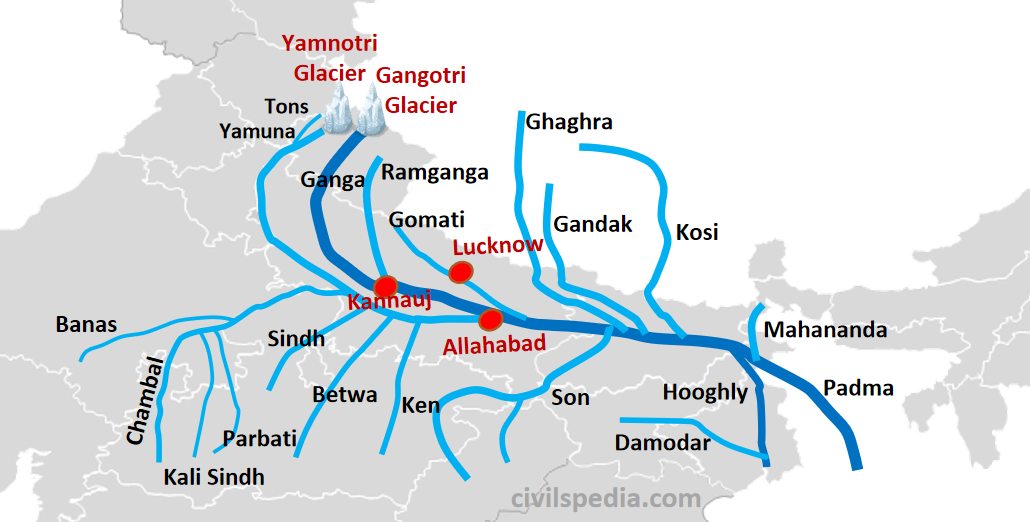
Source: civilspedia.com
- The Yamuna River is the largest tributary of the Ganga River, originating from the Yamunotri glacier at Bandarpoonch peak in Uttarakhand.
- Its main tributaries include: Tons (largest tributary), Sin, Hindon, Betwa, Ken, and Chambal.
- The Yamuna's catchment area spans across several states, including Delhi, Himachal Pradesh, Uttar Pradesh, Haryana, Rajasthan, and Madhya Pradesh.
#5. Narmada River System
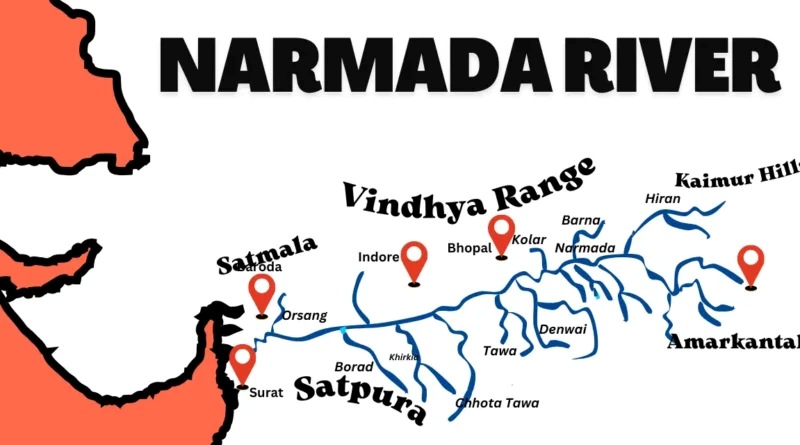
Source: Rivers Insight
- The Narmada River is located in central India, originating from the Amarkantak Hill in Madhya Pradesh.
- It marks the traditional boundary between North and South India.
- The river flows westward, one of the few rivers in India to do so, along with the Tapti and Mahi rivers.
- The Narmada traverses through the states of Madhya Pradesh, Gujarat, and Maharashtra before draining into the Arabian Sea in the Bharuch district of Gujarat.
#6. Tapi River System
- The Tapi River is a central Indian river that flows from east to west, originating in the Eastern Satpura Range of southern Madhya Pradesh.
- It flows westward through historic regions like Madhya Pradesh's Nimar, Maharashtra's Khandesh, and South Gujarat before draining into the Gulf of Cambay in the Arabian Sea.
- The Tapi River Basin primarily lies in eastern and northern Maharashtra, with parts extending into Madhya Pradesh and Gujarat.
- Its principal tributaries include the Waghur River, Aner River, Girna River, Purna River, Panzara River, and Bori River.
- The Tapi River is an important river in peninsular India, known for its westward flow.
#7. Godavari River System
- The Godavari River is the second-longest river in India, often called the Dakshin Ganga or Vriddh Ganga.
- It originates from Trimbakeshwar near Nasik in Maharashtra and flows southeast through Madhya Pradesh, Telangana, Andhra Pradesh, and Odisha before draining into the Bay of Bengal.
- The river is seasonal, widening during monsoons and drying during summers.
- It forms a fertile delta at Rajahmundry and has many pilgrimage sites along its banks, including Nasik, Bhadrachalam, and Trimbak.
- Some of its key tributaries include the Pranahita (a combination of the Penuganga and Wardha), the Indravati River, the Bindusara, the Sabari, and the Manjira river.
- The Godavari River is also home to Asia's largest rail-cum-road bridge, connecting Kovvur and Rajahmundry.
#8. Krishna River System
- The Krishna River is one of India's longest rivers, originating from Mahabaleshwar in Maharashtra.
- It flows through the states of Maharashtra, Karnataka, Telangana, and Andhra Pradesh before draining into the Bay of Bengal.
- Some of its key tributaries include the Tungabhadra River (formed by Tunga and Bhadra rivers), Dudhganga, Koyna, Bhima, Mallaprabha, Dindi, Ghataprabha, Warna, Yerla, and Musi.
- The Krishna River flows through Sangli before emptying into the Bay of Bengal.
#9. Kaveri (Cauvery) River System
- The Kaveri River originates from Talakaveri in the Western Ghats, located in the Kodagu district of Karnataka.
- It's a significant pilgrimage and tourist site.
- The river flows through Karnataka and Tamil Nadu before draining into the Bay of Bengal.
- The Kaveri supports agriculture through irrigation and has historically sustained ancient kingdoms and modern cities in South India.
- Some of its key tributaries include the Arkavathy, Shimsha, Hemavati, Kapila, Honnuhole, Amaravati, Lakshmana, Kabini, Lokapavani, Bhavananadi, Bhavani, Noyyal, and Tirtha.
- The Kaveri River is a vital source of water and spiritual significance in South India.
#10. Mahanadi River System
- The Mahanadi River originates from the Satpura Range in central India and flows eastward through eastern India.
- It drains into the Bay of Bengal and passes through the states of Maharashtra, Chhattisgarh, Jharkhand, and Odisha.
- One of its notable features is the Hirakud Dam, one of the largest dams in India, built across the river.
List of All Rivers in India
According to the Food and Agriculture Organisation, India's river systems are combined into 20 river units, including 14 major river systems and 99 smaller river basins grouped into six river units.
| Rank | River | Length (km) | Origin | Outflow | Major Tributaries | States/UT |
| 1 | Indus | 3,180 | Himalayas | Arabian Sea | Panjnad, Shyok, Dras, Zanskar | Ladakh, Gujarat |
| 2 | Brahmaputra | 2,880 | Bay of Bengal | Lhasa, Lohit, Subansiri, Teesta | Arunachal Pradesh, Assam | |
| 3 | Ganges | 2,525 | Yamuna, Ghaghara, Gomti, Gandaki, Kosi, Son | Uttarakhand, Uttar Pradesh, Bihar, Jharkhand, West Bengal | ||
| 4 | Godavari | 1,465 | Western Ghats | Manjira, Indravati, Sabari, Purna | Maharashtra, Telangana, Andhra Pradesh | |
| 5 | Sutlej | 1,450 | Himalayas | Indus | Chenab, Beas | Himachal Pradesh, Punjab |
| 6 | Krishna | 1,400 | Western Ghats | Bay of Bengal | Bhima, Tungabhadra, Ghataprabha | Maharashtra, Karnataka, Telangana, Andhra Pradesh |
| 7 | Yamuna | 1,376 | Himalayas | Ganges | Chambal, Betwa, Ken | Uttarakhand, Uttar Pradesh, Haryana, Delhi |
| 8 | Narmada | 1,312 | Vindhya and Satpura | Arabian Sea | Kolar, Sher, Tawa | Madhya Pradesh, Maharashtra, Gujarat |
| 9 | Ghaghara | 1,080 | Himalayas |
Ganges | Seti, Bheri | Uttar Pradesh, Bihar |
| 10 | Chambal | 1,024 | Vindhya and Satpura | Banas, Parbati, Shipra | Madhya Pradesh, Rajasthan, Uttar Pradesh | |
| 11 | Mahanadi | 900 | Eastern Ghats | Bay of Bengal | Hasdeo, Seonath, Jonk, Ong River | Chhattisgarh, Odisha |
| 12 | Chenab | 890 | Himalayas | Sutlej | Ravi, Jhelum, Tawi | Himachal Pradesh, Jammu and Kashmir |
| 13 | Kaveri | 805 | Western Ghats | Bay of Bengal | Amaravati, Hemavati, Bhavani, Noyyal | Karnataka, Tamil Nadu |
| 14 | Sone | 784 | Vindhya and Satpura | Ganges | Gopad, Rihand, Kanhar | Chhattisgarh, Madhya Pradesh, Uttar Pradesh, Jharkhand, Bihar |
| 15 | Jhelum | 729 | Himalayas | Chenab | Poonch, Lidder, Neelum | Jammu and Kashmir |
| 16 | Ravi | 720 | Budhil, Baira, Siul, Tant Giri, Sewa, Chirchind Nallah, Bhadal, Ujh, Bein and Basantar | Himachal Pradesh, Punjab | ||
| 17 | Kosi | 720 | Ganges | Sun Kosi, Arun, Tamur | Uttarakhand, Uttar Pradesh, Bihar |
What's Next| Which is the Longest River in the World?
Comments
All Comments (0)
Join the conversation